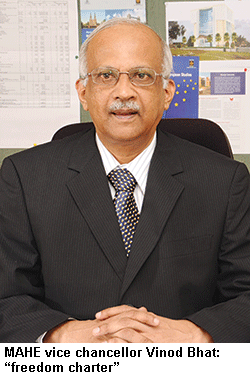 IN A SIGNIFICANT STEP TOWARDS liberalisation of india’s strictly controlled higher education sector, the Delhi-based University Grants Commission (UGC) has granted unprecedented autonomy to 60 higher education institutions across the country, including 52 Central, state, deemed and private universities plus eight autonomous colleges. Although these select institutions, which are highly rated by the Bangalore-based National Assessment and Accreditation Council (NAAC, estb. 1994), will remain under the administrative jurisdiction of UGC, henceforth they will have the freedom to start new courses, establish off-campus learning centres, introduce new skill development programmes and establish research parks.
IN A SIGNIFICANT STEP TOWARDS liberalisation of india’s strictly controlled higher education sector, the Delhi-based University Grants Commission (UGC) has granted unprecedented autonomy to 60 higher education institutions across the country, including 52 Central, state, deemed and private universities plus eight autonomous colleges. Although these select institutions, which are highly rated by the Bangalore-based National Assessment and Accreditation Council (NAAC, estb. 1994), will remain under the administrative jurisdiction of UGC, henceforth they will have the freedom to start new courses, establish off-campus learning centres, introduce new skill development programmes and establish research parks.
They will also have the freedom “to hire foreign faculty, enroll foreign students, give incentive-based emoluments to the faculty, enter into academic collaborations and run open distance learning programmes,” according to a March 20 press note issued by the Press Information Bureau (PIB) of the Central government. Hitherto, any and all these initiatives required prior written permission of UGC, which was seldom given.
Moreover, the eight colleges also conferred autonomy will be “free to set their own syllabus, hold examinations, carry out evaluation as well as declare results... only the degree will be awarded by the respective university,” says the PIB press note.
Five universities in Karnataka — University of Mysore; Jain University, Bangalore; Manipal Academy of Higher Education; KLE Academy of Higher Education and Research, Belagavi; JSS Academy of Higher Education and Research, Mysore — are in the list released by Union human resource development (HRD) minister Prakash Javadekar on March 20.
However, although all the selected 60 higher education institutions have been granted autonomy which is substantial and real — and beyond the expectation of the most liberal academics — some higher ed institutions awarded NAAC rating above 3.5 are classified as category I (institutions with NAAC rating of 3.26-3.5 are classified as category II) and are more equal than others. Two Central (JNU, Delhi & Hyderabad University); 12 state (including Jadavpur, Kolkata, Anna University, Chennai and Punjabi University, Patiala), 11 deemed (including Symbiosis, Pune and NMIMS, Mumbai universities) are classified as category I. As such they are conferred all the freedoms awarded to category II institutions and the additional freedom of being beyond UGC inspection.
All the other 35 institutions of higher education awarded autonomy have been conferred category II status. However, in real terms difference in the degree of autonomy conferred upon category I and category II institutions is marginal.
“For us, the conferment of autonomy is a freedom charter,” says Dr. H. Vinod Bhat, vice chancellor of Manipal Academy of Higher Education (MAHE), ranked India’s #1 private university by EducationWorld last year. “UGC’s grant of autonomy will enable us to start colleges, introduce new study programmes and establish learning centres quickly. We can now rollout our plan to establish three new campuses — a medical college in Jamshedpur, a campus offering new age programmes such as humanities, business, management and art in Bangalore, and an international campus in Colombo which will include a medical college in the second phase. Now we are looking forward to MAHE being included in the Central government’s list of ten private institutes of eminence which will receive government grants to meet more challenging goals,” says Bhat.
Likewise, Dr. Sandeep Shastri, pro-vice chancellor of Jain University, Bangalore, which has been conferred category II autonomy, is delighted with the recognition. “The grant of substantial autonomy will give us more space and flexibility for innovation and working towards achieving our long term goals and focus on innovating and introducing new programmes such as corporate finance, strategy and leadership, and international marketing. We will also add to our highly motivated faculty and set up campuses in other cities,” says Shastri.
Although much to the surprise of the academy, the BJP/NDA government at the Centre has conferred substantial rather than ritual autonomy on these selected 60 institutions of higher education, there are several grey areas. One wonders whether these institutions which include Central and state universities will be free to charge realistic tuition fees which are currently rock bottom. Students in India’s higher education institutions contribute less than 5 percent — against the global norm of 20 percent — of institutional expenditure. Freedom to hire foreign faculty, establish new campuses etc will be meaningless without addressing such structural issues.
Sruthy Susan Ullas (Bangalore)